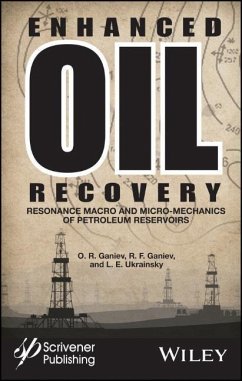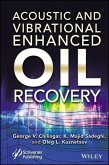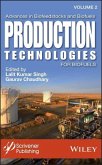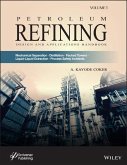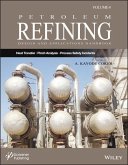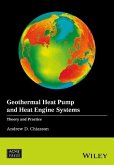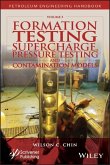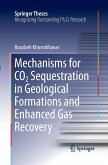O. R. Ganiev, R. F. Ganiev, L. E. Ukrainsky
Enhanced Oil Recovery
Resonance Macro- And Micro-Mechanics of Petroleum Reservoirs
O. R. Ganiev, R. F. Ganiev, L. E. Ukrainsky
Enhanced Oil Recovery
Resonance Macro- And Micro-Mechanics of Petroleum Reservoirs
- Gebundenes Buch
- Merkliste
- Auf die Merkliste
- Bewerten Bewerten
- Teilen
- Produkt teilen
- Produkterinnerung
- Produkterinnerung
Fossil fuels, especially petroleum, are still the primary energy source all over the world. With the advent of hydraulic fracturing (i.e. "fracking"), directional drilling, and other technological advances, petroleum and reservoir engineers all over the world have been able to produce much greater results, in much more difficult areas, than ever before, to meet higher global demand. "Enhanced oil recovery (EOR)" is one of the hottest and most important topics in this industry. New technologies and processes must be continually discovered and developed, even as renewable energy begins to grow…mehr
Andere Kunden interessierten sich auch für
![Acoustic and Vibrational Enhanced Oil Recovery Acoustic and Vibrational Enhanced Oil Recovery]() George V. ChilingarAcoustic and Vibrational Enhanced Oil Recovery214,99 €
George V. ChilingarAcoustic and Vibrational Enhanced Oil Recovery214,99 €![Advances in Biofeedstocks and Biofuels, Production Technologies for Biofuels Advances in Biofeedstocks and Biofuels, Production Technologies for Biofuels]() Advances in Biofeedstocks and Biofuels, Production Technologies for Biofuels242,99 €
Advances in Biofeedstocks and Biofuels, Production Technologies for Biofuels242,99 €![Petroleum Refining Design and Applications Handbook, Volume 3 Petroleum Refining Design and Applications Handbook, Volume 3]() Petroleum Refining Design and Applications Handbook, Volume 3299,99 €
Petroleum Refining Design and Applications Handbook, Volume 3299,99 €![Petroleum Refining Design and Applications Handbook, Volume 4 Petroleum Refining Design and Applications Handbook, Volume 4]() A. Kayode CokerPetroleum Refining Design and Applications Handbook, Volume 4341,99 €
A. Kayode CokerPetroleum Refining Design and Applications Handbook, Volume 4341,99 €![Geothermal Heat Pump and Heat Engine Systems Geothermal Heat Pump and Heat Engine Systems]() Andrew D. ChiassonGeothermal Heat Pump and Heat Engine Systems143,99 €
Andrew D. ChiassonGeothermal Heat Pump and Heat Engine Systems143,99 €![Formation Testing Formation Testing]() Wilson ChinFormation Testing232,99 €
Wilson ChinFormation Testing232,99 €![Mechanisms for CO2 Sequestration in Geological Formations and Enhanced Gas Recovery Mechanisms for CO2 Sequestration in Geological Formations and Enhanced Gas Recovery]() Roozbeh KhosrokhavarMechanisms for CO2 Sequestration in Geological Formations and Enhanced Gas Recovery75,99 €
Roozbeh KhosrokhavarMechanisms for CO2 Sequestration in Geological Formations and Enhanced Gas Recovery75,99 €-
-
-
Fossil fuels, especially petroleum, are still the primary energy source all over the world. With the advent of hydraulic fracturing (i.e. "fracking"), directional drilling, and other technological advances, petroleum and reservoir engineers all over the world have been able to produce much greater results, in much more difficult areas, than ever before, to meet higher global demand. "Enhanced oil recovery (EOR)" is one of the hottest and most important topics in this industry. New technologies and processes must be continually discovered and developed, even as renewable energy begins to grow and become more fruitful, as the demand for more and more energy continues to grow worldwide.
This groundbreaking and highly anticipated study discusses the scientific fundamentals of resonance macro- and micro-mechanics of petroleum reservoirs and its petroleum industry applications. It contains an overview of the research and engineering results of resonance macro- and micro-mechanics of petroleum reservoirs, which provide the scientific and applied foundations for the creation of groundbreaking wave technologies for production stimulation and enhanced oil recovery.
A valuable tool for the petroleum or reservoir engineer in the field, this volume is also intended for students, teachers, scientists and practitioners who are interested in the fundamentals, development, and application of leading-edge technologies in the petroleum industry and other industrial sectors.
Hinweis: Dieser Artikel kann nur an eine deutsche Lieferadresse ausgeliefert werden.
This groundbreaking and highly anticipated study discusses the scientific fundamentals of resonance macro- and micro-mechanics of petroleum reservoirs and its petroleum industry applications. It contains an overview of the research and engineering results of resonance macro- and micro-mechanics of petroleum reservoirs, which provide the scientific and applied foundations for the creation of groundbreaking wave technologies for production stimulation and enhanced oil recovery.
A valuable tool for the petroleum or reservoir engineer in the field, this volume is also intended for students, teachers, scientists and practitioners who are interested in the fundamentals, development, and application of leading-edge technologies in the petroleum industry and other industrial sectors.
Hinweis: Dieser Artikel kann nur an eine deutsche Lieferadresse ausgeliefert werden.
Produktdetails
- Produktdetails
- Verlag: Wiley & Sons / Wiley-Scrivener
- Artikelnr. des Verlages: 1W119293820
- 1. Auflage
- Seitenzahl: 240
- Erscheinungstermin: 12. Dezember 2016
- Englisch
- Abmessung: 231mm x 155mm x 15mm
- Gewicht: 502g
- ISBN-13: 9781119293828
- ISBN-10: 1119293820
- Artikelnr.: 45161376
- Herstellerkennzeichnung
- Libri GmbH
- Europaallee 1
- 36244 Bad Hersfeld
- gpsr@libri.de
- Verlag: Wiley & Sons / Wiley-Scrivener
- Artikelnr. des Verlages: 1W119293820
- 1. Auflage
- Seitenzahl: 240
- Erscheinungstermin: 12. Dezember 2016
- Englisch
- Abmessung: 231mm x 155mm x 15mm
- Gewicht: 502g
- ISBN-13: 9781119293828
- ISBN-10: 1119293820
- Artikelnr.: 45161376
- Herstellerkennzeichnung
- Libri GmbH
- Europaallee 1
- 36244 Bad Hersfeld
- gpsr@libri.de
Oleg R. Ganiev, D.Sc. (Technical Sciences), is the Chief Researcher at the Scientific Center for Nonlinear Wave Mechanics and Technology of the Russian Academy of Sciences (NWMTC RAN), a subsidiary of IMASH RAN. O. R. Ganiev is an expert in theoretical and applied mechanics, the theory of nonlinear oscillations of multiphase systems, and fluid mechanics. Rivner F. Ganiev, D.Sc. (Technical Sciences), is a Member of the Russian Academy of Sciences, Professor, the Scientific Director of the A. A. Blagonravov Institute of Machine Science of the Russian Academy of Sciences (IMASH RAN), the Director of the Scientific Center for Nonlinear Wave Mechanics and Technology of the Russian Academy of Sciences (NWMTC RAN), Head of the Department of Computational Models for Technological Processes of the Moscow Institute of Physics and Technology, Head of the Department of Applied Physics of the Moscow Aviation Institute. R. F. Ganiev is an expert in mechanics and engineering, nonlinear oscillations and wave processes, dynamics of machines and equipment, and wave technologies in various engineering applications. Leonid E. Ukrainskiy, D.Sc. (Technical Sciences) is the Deputy Director of the Scientific Center for Nonlinear Wave Mechanics and Technology of the Russian Academy of Sciences (NWMTC RAN), a subsidiary of IMASH RAN. L. E. Ukrainskiy is an expert in theoretical and applied mechanics, the theory of nonlinear oscillations of multiphase systems, and fluid mechanics.
Preface xiii
Introduction: A Brief Historical Background and Description of the Problem
xvii
1 Scientific Foundation for Enhanced Oil Recovery and Production
Stimulation 1
1.1 The Practical Results of Near-Wellbore Formation Cleaning by Wave
Stimulation 1
1.2 The Scientific Fundamentals of the First-Generation Wave Technology for
Stimulation of Production Processes 7
1.2.1 Large-Scale Laboratory Experiments at Shell Test Facilities 8
1.2.2 Resonances in Near-Wellbore Formation. Resonances in Perforations 12
1.2.3 Excitation of Oscillations in Micro-Pores by One- Dimensional
Longitudinal Macro-Waves in a Medium. Resonances. Transformation of
Micro-Oscillations in Pores to Macro-Flows of Fluid. Th e Capillary Effect
15
1.2.4 Cleaning of Horizontal Wells 18
1.2.5 Preliminary Results 20
1.3 Stimulation of Entire Reservoirs by First-Generation Wave Methods for
Enhanced Oil Recovery. Resonance Macro- and Micro-Mechanics of Petroleum
Reservoirs: A Scientific Foundation for Enhanced Oil Recovery 21
2 Remove Micro-Particles by Harmonic External Actions 27
2.1 An Analysis of the Forces Acting on Pore-Contaminating Particles under
a Harmonic External Action 27
2.2 Conditions for the Detachment of a Solid Particle from the Wall of a
Pore under Harmonic External Action 30
2.3 The Criterion of Successful Harmonic Wave Stimulation. Criterion
Determination Procedure 39
2.4 Summary 43
3 Remove Micro-Particles by Impact Waves 45
3.1 Determining Flow Parameters behind an Impact Wave 46
3.2 Assessing the Forces That Act on a Particle as the Front of an Impact
Wave Is Passing 51
3.3 Conditions for the Detachment of a Solid Particle from the Wall of a
Pore under the Action of a Passing Impact Wave 53
3.4 The Criterion for Successful Wave Stimulation by Impact Waves.
Criterion Determination Procedure 58
3.5 Summary 61
4 The Wave Mechanisms of Motion of Capillary-Trapped Oil 63
4.1 The Conditions for the Detachment of a Droplet from the Wall of a Pore
64
4.2 The Case of Harmonic Action on a Capillary-Trapped Droplet 66
4.3 The Case of Impact Wave Action on a Capillary-Trapped Droplet 70
4.4 Summary 72
5 Action of Wave Forces on Fluid Droplets and Solid Particles in Pore
Channels 73
5.1 The Mechanism of Trapping of Large Oil Droplets in a Waterflooded
Reservoir. Propulsion of Droplets by One-Dimensional Nonlinear Wave Forces
73
5.2 The Average Flow of Fluid Caused by Oscillations in a Saturated Porous
Medium with a Stationary Matrix and Inhomogeneous Porosity 76
5.2.1 The Statement of the Problem 76
5.2.2 Calculation Results 79
5.3 Fluid Flows Caused by Oscillations in Cone-Shaped Pores 84
5.3.1 The Statement of the Problem 84
5.3.2 Calculation Results 88
6 The Mobilization of Droplets and Blobs of Capillary-Trapped Oil from
Microcavities 91
6.1 The Mathematical Statement of the Problem 91
6.2 The Natural Frequency of Gravity-Capillary Waves on Oil-Water and
Oil-Surfactant Interfaces in Pores 95
6.3 Interface Instability Range 97
6.4 Oil-Water Interface Instability 98
6.5 Oil-Surfactant Interface Instability 102
7 Statements and Substantiations of Waveguide Mechanics of Porous Media 105
7.1 Resonance Mechanisms Possible in Fluid-Saturated Porous Media 105
7.2 Resonance of Two-Dimensional Axially Symmetric Waves in Horizontal
Layers of Reservoir. Efficient and Directed Excitation of Wave Energy in
Target Sub-Layers 108
7.3 Resonance of Two-dimensional Plane Waves in Reservoir
Compartmentalizing Strike-Slip Faults and Fractured Zones 114
7.3.1 The Mathematical Model of a Fluid-Saturated Porous Medium 115
7.3.2 The Statement of the Problem and Solution Procedure 118
7.3.3 Damping Decrements of Waves in a Natural Vertical Waveguide 121
7.3.4 Statement of a Resonance Waveguide Problem and Its Substantiation for
Porous Media. Introduction 127
7.3.5 Resonances. Waveguide Processes in Porous Media with Heterogeneities.
Th e Distribution of Forces Acting on Pore-Contaminating Solid Particles
and Capillary-Trapped Oil Droplets in a Waveguide 132
7.4 Linked Waveguides in Compartmentalized Reservoirs. The Transfer of
Oscillations into Reservoir Inner Zones under Multidimensional Resonance
Conditions 141
7.4.1 The Statement of the Problem of Forced OneDimensional Oscillations in
Linked Sections of a Multi-Phase Medium under Resonance Conditions 142
7.4.2 The Results of Mathematical Simulation 144
7.5 Experimental Determination of Resonant Frequencies of a Reservoir.
Practical Recommendations for Selecting Controlled Means and
Oscillation/Wave Generators 145
8 The Resonant and Waveguide Characteristics of a Well 151
8.1 Selecting Wave Parameters for Stimulation of Horizontal Wells 153
8.1.1 Scientifi c Fundamentals 153
8.1.2 Practical Recommendations on Stimulation of Horizontal Wells 158
8.2 Near-Wellbore Stimulation. The Induction of Resonance 159
8.2.1 Resonances in the Wellbore Section between the Oscillation Generator
and the Bottom. Using Waves to Transfer Wave Energy 159
8.2.2 Practical Recommendations for Stimulation of the Near-Wellbore
Formation Zone 162
9 Experimental Study of Wave Action on a Fluid-Filled Porous Medium 165
9.1 Experimental Study of the Potential to Clean up the Near-Wellbore
Formation Zone from Contamination using Wave Stimulation 165
9.1.1 Test Equipment and Methodology 166
9.1.2 The Results of Cleanup from Clay Mud 169
9.1.3 The Results of Cleanup from Clay-Polymer Mud 171
9.1.4 Summary 173
9.2 The Experimental Study of the Eff ect of Shock Waves on the
Displacement of Hydrocarbons by Water in a Porous Medium. Connected Wells
173
9.2.1 The Test Equipment 174
9.2.2 A Theoretical Analysis of the Propagation of Waves Generated by a
Shock-Wave Valve in the Test Facilities and Evaluation of the Forces Caused
by the Wave Action 177
9.2.3 The Methodology of Tests 180
9.2.4 Results of Flow Acceleration Tests 181
9.2.5 The Effect of Wave Stimulation on Connected Wells 185
9.2.6 Summary 186
Conclusion 189
References 195
Index 201
Introduction: A Brief Historical Background and Description of the Problem
xvii
1 Scientific Foundation for Enhanced Oil Recovery and Production
Stimulation 1
1.1 The Practical Results of Near-Wellbore Formation Cleaning by Wave
Stimulation 1
1.2 The Scientific Fundamentals of the First-Generation Wave Technology for
Stimulation of Production Processes 7
1.2.1 Large-Scale Laboratory Experiments at Shell Test Facilities 8
1.2.2 Resonances in Near-Wellbore Formation. Resonances in Perforations 12
1.2.3 Excitation of Oscillations in Micro-Pores by One- Dimensional
Longitudinal Macro-Waves in a Medium. Resonances. Transformation of
Micro-Oscillations in Pores to Macro-Flows of Fluid. Th e Capillary Effect
15
1.2.4 Cleaning of Horizontal Wells 18
1.2.5 Preliminary Results 20
1.3 Stimulation of Entire Reservoirs by First-Generation Wave Methods for
Enhanced Oil Recovery. Resonance Macro- and Micro-Mechanics of Petroleum
Reservoirs: A Scientific Foundation for Enhanced Oil Recovery 21
2 Remove Micro-Particles by Harmonic External Actions 27
2.1 An Analysis of the Forces Acting on Pore-Contaminating Particles under
a Harmonic External Action 27
2.2 Conditions for the Detachment of a Solid Particle from the Wall of a
Pore under Harmonic External Action 30
2.3 The Criterion of Successful Harmonic Wave Stimulation. Criterion
Determination Procedure 39
2.4 Summary 43
3 Remove Micro-Particles by Impact Waves 45
3.1 Determining Flow Parameters behind an Impact Wave 46
3.2 Assessing the Forces That Act on a Particle as the Front of an Impact
Wave Is Passing 51
3.3 Conditions for the Detachment of a Solid Particle from the Wall of a
Pore under the Action of a Passing Impact Wave 53
3.4 The Criterion for Successful Wave Stimulation by Impact Waves.
Criterion Determination Procedure 58
3.5 Summary 61
4 The Wave Mechanisms of Motion of Capillary-Trapped Oil 63
4.1 The Conditions for the Detachment of a Droplet from the Wall of a Pore
64
4.2 The Case of Harmonic Action on a Capillary-Trapped Droplet 66
4.3 The Case of Impact Wave Action on a Capillary-Trapped Droplet 70
4.4 Summary 72
5 Action of Wave Forces on Fluid Droplets and Solid Particles in Pore
Channels 73
5.1 The Mechanism of Trapping of Large Oil Droplets in a Waterflooded
Reservoir. Propulsion of Droplets by One-Dimensional Nonlinear Wave Forces
73
5.2 The Average Flow of Fluid Caused by Oscillations in a Saturated Porous
Medium with a Stationary Matrix and Inhomogeneous Porosity 76
5.2.1 The Statement of the Problem 76
5.2.2 Calculation Results 79
5.3 Fluid Flows Caused by Oscillations in Cone-Shaped Pores 84
5.3.1 The Statement of the Problem 84
5.3.2 Calculation Results 88
6 The Mobilization of Droplets and Blobs of Capillary-Trapped Oil from
Microcavities 91
6.1 The Mathematical Statement of the Problem 91
6.2 The Natural Frequency of Gravity-Capillary Waves on Oil-Water and
Oil-Surfactant Interfaces in Pores 95
6.3 Interface Instability Range 97
6.4 Oil-Water Interface Instability 98
6.5 Oil-Surfactant Interface Instability 102
7 Statements and Substantiations of Waveguide Mechanics of Porous Media 105
7.1 Resonance Mechanisms Possible in Fluid-Saturated Porous Media 105
7.2 Resonance of Two-Dimensional Axially Symmetric Waves in Horizontal
Layers of Reservoir. Efficient and Directed Excitation of Wave Energy in
Target Sub-Layers 108
7.3 Resonance of Two-dimensional Plane Waves in Reservoir
Compartmentalizing Strike-Slip Faults and Fractured Zones 114
7.3.1 The Mathematical Model of a Fluid-Saturated Porous Medium 115
7.3.2 The Statement of the Problem and Solution Procedure 118
7.3.3 Damping Decrements of Waves in a Natural Vertical Waveguide 121
7.3.4 Statement of a Resonance Waveguide Problem and Its Substantiation for
Porous Media. Introduction 127
7.3.5 Resonances. Waveguide Processes in Porous Media with Heterogeneities.
Th e Distribution of Forces Acting on Pore-Contaminating Solid Particles
and Capillary-Trapped Oil Droplets in a Waveguide 132
7.4 Linked Waveguides in Compartmentalized Reservoirs. The Transfer of
Oscillations into Reservoir Inner Zones under Multidimensional Resonance
Conditions 141
7.4.1 The Statement of the Problem of Forced OneDimensional Oscillations in
Linked Sections of a Multi-Phase Medium under Resonance Conditions 142
7.4.2 The Results of Mathematical Simulation 144
7.5 Experimental Determination of Resonant Frequencies of a Reservoir.
Practical Recommendations for Selecting Controlled Means and
Oscillation/Wave Generators 145
8 The Resonant and Waveguide Characteristics of a Well 151
8.1 Selecting Wave Parameters for Stimulation of Horizontal Wells 153
8.1.1 Scientifi c Fundamentals 153
8.1.2 Practical Recommendations on Stimulation of Horizontal Wells 158
8.2 Near-Wellbore Stimulation. The Induction of Resonance 159
8.2.1 Resonances in the Wellbore Section between the Oscillation Generator
and the Bottom. Using Waves to Transfer Wave Energy 159
8.2.2 Practical Recommendations for Stimulation of the Near-Wellbore
Formation Zone 162
9 Experimental Study of Wave Action on a Fluid-Filled Porous Medium 165
9.1 Experimental Study of the Potential to Clean up the Near-Wellbore
Formation Zone from Contamination using Wave Stimulation 165
9.1.1 Test Equipment and Methodology 166
9.1.2 The Results of Cleanup from Clay Mud 169
9.1.3 The Results of Cleanup from Clay-Polymer Mud 171
9.1.4 Summary 173
9.2 The Experimental Study of the Eff ect of Shock Waves on the
Displacement of Hydrocarbons by Water in a Porous Medium. Connected Wells
173
9.2.1 The Test Equipment 174
9.2.2 A Theoretical Analysis of the Propagation of Waves Generated by a
Shock-Wave Valve in the Test Facilities and Evaluation of the Forces Caused
by the Wave Action 177
9.2.3 The Methodology of Tests 180
9.2.4 Results of Flow Acceleration Tests 181
9.2.5 The Effect of Wave Stimulation on Connected Wells 185
9.2.6 Summary 186
Conclusion 189
References 195
Index 201
Preface xiii
Introduction: A Brief Historical Background and Description of the Problem
xvii
1 Scientific Foundation for Enhanced Oil Recovery and Production
Stimulation 1
1.1 The Practical Results of Near-Wellbore Formation Cleaning by Wave
Stimulation 1
1.2 The Scientific Fundamentals of the First-Generation Wave Technology for
Stimulation of Production Processes 7
1.2.1 Large-Scale Laboratory Experiments at Shell Test Facilities 8
1.2.2 Resonances in Near-Wellbore Formation. Resonances in Perforations 12
1.2.3 Excitation of Oscillations in Micro-Pores by One- Dimensional
Longitudinal Macro-Waves in a Medium. Resonances. Transformation of
Micro-Oscillations in Pores to Macro-Flows of Fluid. Th e Capillary Effect
15
1.2.4 Cleaning of Horizontal Wells 18
1.2.5 Preliminary Results 20
1.3 Stimulation of Entire Reservoirs by First-Generation Wave Methods for
Enhanced Oil Recovery. Resonance Macro- and Micro-Mechanics of Petroleum
Reservoirs: A Scientific Foundation for Enhanced Oil Recovery 21
2 Remove Micro-Particles by Harmonic External Actions 27
2.1 An Analysis of the Forces Acting on Pore-Contaminating Particles under
a Harmonic External Action 27
2.2 Conditions for the Detachment of a Solid Particle from the Wall of a
Pore under Harmonic External Action 30
2.3 The Criterion of Successful Harmonic Wave Stimulation. Criterion
Determination Procedure 39
2.4 Summary 43
3 Remove Micro-Particles by Impact Waves 45
3.1 Determining Flow Parameters behind an Impact Wave 46
3.2 Assessing the Forces That Act on a Particle as the Front of an Impact
Wave Is Passing 51
3.3 Conditions for the Detachment of a Solid Particle from the Wall of a
Pore under the Action of a Passing Impact Wave 53
3.4 The Criterion for Successful Wave Stimulation by Impact Waves.
Criterion Determination Procedure 58
3.5 Summary 61
4 The Wave Mechanisms of Motion of Capillary-Trapped Oil 63
4.1 The Conditions for the Detachment of a Droplet from the Wall of a Pore
64
4.2 The Case of Harmonic Action on a Capillary-Trapped Droplet 66
4.3 The Case of Impact Wave Action on a Capillary-Trapped Droplet 70
4.4 Summary 72
5 Action of Wave Forces on Fluid Droplets and Solid Particles in Pore
Channels 73
5.1 The Mechanism of Trapping of Large Oil Droplets in a Waterflooded
Reservoir. Propulsion of Droplets by One-Dimensional Nonlinear Wave Forces
73
5.2 The Average Flow of Fluid Caused by Oscillations in a Saturated Porous
Medium with a Stationary Matrix and Inhomogeneous Porosity 76
5.2.1 The Statement of the Problem 76
5.2.2 Calculation Results 79
5.3 Fluid Flows Caused by Oscillations in Cone-Shaped Pores 84
5.3.1 The Statement of the Problem 84
5.3.2 Calculation Results 88
6 The Mobilization of Droplets and Blobs of Capillary-Trapped Oil from
Microcavities 91
6.1 The Mathematical Statement of the Problem 91
6.2 The Natural Frequency of Gravity-Capillary Waves on Oil-Water and
Oil-Surfactant Interfaces in Pores 95
6.3 Interface Instability Range 97
6.4 Oil-Water Interface Instability 98
6.5 Oil-Surfactant Interface Instability 102
7 Statements and Substantiations of Waveguide Mechanics of Porous Media 105
7.1 Resonance Mechanisms Possible in Fluid-Saturated Porous Media 105
7.2 Resonance of Two-Dimensional Axially Symmetric Waves in Horizontal
Layers of Reservoir. Efficient and Directed Excitation of Wave Energy in
Target Sub-Layers 108
7.3 Resonance of Two-dimensional Plane Waves in Reservoir
Compartmentalizing Strike-Slip Faults and Fractured Zones 114
7.3.1 The Mathematical Model of a Fluid-Saturated Porous Medium 115
7.3.2 The Statement of the Problem and Solution Procedure 118
7.3.3 Damping Decrements of Waves in a Natural Vertical Waveguide 121
7.3.4 Statement of a Resonance Waveguide Problem and Its Substantiation for
Porous Media. Introduction 127
7.3.5 Resonances. Waveguide Processes in Porous Media with Heterogeneities.
Th e Distribution of Forces Acting on Pore-Contaminating Solid Particles
and Capillary-Trapped Oil Droplets in a Waveguide 132
7.4 Linked Waveguides in Compartmentalized Reservoirs. The Transfer of
Oscillations into Reservoir Inner Zones under Multidimensional Resonance
Conditions 141
7.4.1 The Statement of the Problem of Forced OneDimensional Oscillations in
Linked Sections of a Multi-Phase Medium under Resonance Conditions 142
7.4.2 The Results of Mathematical Simulation 144
7.5 Experimental Determination of Resonant Frequencies of a Reservoir.
Practical Recommendations for Selecting Controlled Means and
Oscillation/Wave Generators 145
8 The Resonant and Waveguide Characteristics of a Well 151
8.1 Selecting Wave Parameters for Stimulation of Horizontal Wells 153
8.1.1 Scientifi c Fundamentals 153
8.1.2 Practical Recommendations on Stimulation of Horizontal Wells 158
8.2 Near-Wellbore Stimulation. The Induction of Resonance 159
8.2.1 Resonances in the Wellbore Section between the Oscillation Generator
and the Bottom. Using Waves to Transfer Wave Energy 159
8.2.2 Practical Recommendations for Stimulation of the Near-Wellbore
Formation Zone 162
9 Experimental Study of Wave Action on a Fluid-Filled Porous Medium 165
9.1 Experimental Study of the Potential to Clean up the Near-Wellbore
Formation Zone from Contamination using Wave Stimulation 165
9.1.1 Test Equipment and Methodology 166
9.1.2 The Results of Cleanup from Clay Mud 169
9.1.3 The Results of Cleanup from Clay-Polymer Mud 171
9.1.4 Summary 173
9.2 The Experimental Study of the Eff ect of Shock Waves on the
Displacement of Hydrocarbons by Water in a Porous Medium. Connected Wells
173
9.2.1 The Test Equipment 174
9.2.2 A Theoretical Analysis of the Propagation of Waves Generated by a
Shock-Wave Valve in the Test Facilities and Evaluation of the Forces Caused
by the Wave Action 177
9.2.3 The Methodology of Tests 180
9.2.4 Results of Flow Acceleration Tests 181
9.2.5 The Effect of Wave Stimulation on Connected Wells 185
9.2.6 Summary 186
Conclusion 189
References 195
Index 201
Introduction: A Brief Historical Background and Description of the Problem
xvii
1 Scientific Foundation for Enhanced Oil Recovery and Production
Stimulation 1
1.1 The Practical Results of Near-Wellbore Formation Cleaning by Wave
Stimulation 1
1.2 The Scientific Fundamentals of the First-Generation Wave Technology for
Stimulation of Production Processes 7
1.2.1 Large-Scale Laboratory Experiments at Shell Test Facilities 8
1.2.2 Resonances in Near-Wellbore Formation. Resonances in Perforations 12
1.2.3 Excitation of Oscillations in Micro-Pores by One- Dimensional
Longitudinal Macro-Waves in a Medium. Resonances. Transformation of
Micro-Oscillations in Pores to Macro-Flows of Fluid. Th e Capillary Effect
15
1.2.4 Cleaning of Horizontal Wells 18
1.2.5 Preliminary Results 20
1.3 Stimulation of Entire Reservoirs by First-Generation Wave Methods for
Enhanced Oil Recovery. Resonance Macro- and Micro-Mechanics of Petroleum
Reservoirs: A Scientific Foundation for Enhanced Oil Recovery 21
2 Remove Micro-Particles by Harmonic External Actions 27
2.1 An Analysis of the Forces Acting on Pore-Contaminating Particles under
a Harmonic External Action 27
2.2 Conditions for the Detachment of a Solid Particle from the Wall of a
Pore under Harmonic External Action 30
2.3 The Criterion of Successful Harmonic Wave Stimulation. Criterion
Determination Procedure 39
2.4 Summary 43
3 Remove Micro-Particles by Impact Waves 45
3.1 Determining Flow Parameters behind an Impact Wave 46
3.2 Assessing the Forces That Act on a Particle as the Front of an Impact
Wave Is Passing 51
3.3 Conditions for the Detachment of a Solid Particle from the Wall of a
Pore under the Action of a Passing Impact Wave 53
3.4 The Criterion for Successful Wave Stimulation by Impact Waves.
Criterion Determination Procedure 58
3.5 Summary 61
4 The Wave Mechanisms of Motion of Capillary-Trapped Oil 63
4.1 The Conditions for the Detachment of a Droplet from the Wall of a Pore
64
4.2 The Case of Harmonic Action on a Capillary-Trapped Droplet 66
4.3 The Case of Impact Wave Action on a Capillary-Trapped Droplet 70
4.4 Summary 72
5 Action of Wave Forces on Fluid Droplets and Solid Particles in Pore
Channels 73
5.1 The Mechanism of Trapping of Large Oil Droplets in a Waterflooded
Reservoir. Propulsion of Droplets by One-Dimensional Nonlinear Wave Forces
73
5.2 The Average Flow of Fluid Caused by Oscillations in a Saturated Porous
Medium with a Stationary Matrix and Inhomogeneous Porosity 76
5.2.1 The Statement of the Problem 76
5.2.2 Calculation Results 79
5.3 Fluid Flows Caused by Oscillations in Cone-Shaped Pores 84
5.3.1 The Statement of the Problem 84
5.3.2 Calculation Results 88
6 The Mobilization of Droplets and Blobs of Capillary-Trapped Oil from
Microcavities 91
6.1 The Mathematical Statement of the Problem 91
6.2 The Natural Frequency of Gravity-Capillary Waves on Oil-Water and
Oil-Surfactant Interfaces in Pores 95
6.3 Interface Instability Range 97
6.4 Oil-Water Interface Instability 98
6.5 Oil-Surfactant Interface Instability 102
7 Statements and Substantiations of Waveguide Mechanics of Porous Media 105
7.1 Resonance Mechanisms Possible in Fluid-Saturated Porous Media 105
7.2 Resonance of Two-Dimensional Axially Symmetric Waves in Horizontal
Layers of Reservoir. Efficient and Directed Excitation of Wave Energy in
Target Sub-Layers 108
7.3 Resonance of Two-dimensional Plane Waves in Reservoir
Compartmentalizing Strike-Slip Faults and Fractured Zones 114
7.3.1 The Mathematical Model of a Fluid-Saturated Porous Medium 115
7.3.2 The Statement of the Problem and Solution Procedure 118
7.3.3 Damping Decrements of Waves in a Natural Vertical Waveguide 121
7.3.4 Statement of a Resonance Waveguide Problem and Its Substantiation for
Porous Media. Introduction 127
7.3.5 Resonances. Waveguide Processes in Porous Media with Heterogeneities.
Th e Distribution of Forces Acting on Pore-Contaminating Solid Particles
and Capillary-Trapped Oil Droplets in a Waveguide 132
7.4 Linked Waveguides in Compartmentalized Reservoirs. The Transfer of
Oscillations into Reservoir Inner Zones under Multidimensional Resonance
Conditions 141
7.4.1 The Statement of the Problem of Forced OneDimensional Oscillations in
Linked Sections of a Multi-Phase Medium under Resonance Conditions 142
7.4.2 The Results of Mathematical Simulation 144
7.5 Experimental Determination of Resonant Frequencies of a Reservoir.
Practical Recommendations for Selecting Controlled Means and
Oscillation/Wave Generators 145
8 The Resonant and Waveguide Characteristics of a Well 151
8.1 Selecting Wave Parameters for Stimulation of Horizontal Wells 153
8.1.1 Scientifi c Fundamentals 153
8.1.2 Practical Recommendations on Stimulation of Horizontal Wells 158
8.2 Near-Wellbore Stimulation. The Induction of Resonance 159
8.2.1 Resonances in the Wellbore Section between the Oscillation Generator
and the Bottom. Using Waves to Transfer Wave Energy 159
8.2.2 Practical Recommendations for Stimulation of the Near-Wellbore
Formation Zone 162
9 Experimental Study of Wave Action on a Fluid-Filled Porous Medium 165
9.1 Experimental Study of the Potential to Clean up the Near-Wellbore
Formation Zone from Contamination using Wave Stimulation 165
9.1.1 Test Equipment and Methodology 166
9.1.2 The Results of Cleanup from Clay Mud 169
9.1.3 The Results of Cleanup from Clay-Polymer Mud 171
9.1.4 Summary 173
9.2 The Experimental Study of the Eff ect of Shock Waves on the
Displacement of Hydrocarbons by Water in a Porous Medium. Connected Wells
173
9.2.1 The Test Equipment 174
9.2.2 A Theoretical Analysis of the Propagation of Waves Generated by a
Shock-Wave Valve in the Test Facilities and Evaluation of the Forces Caused
by the Wave Action 177
9.2.3 The Methodology of Tests 180
9.2.4 Results of Flow Acceleration Tests 181
9.2.5 The Effect of Wave Stimulation on Connected Wells 185
9.2.6 Summary 186
Conclusion 189
References 195
Index 201

